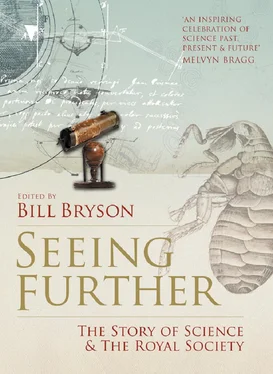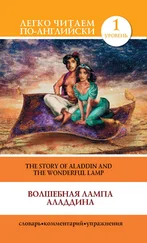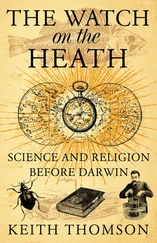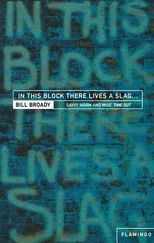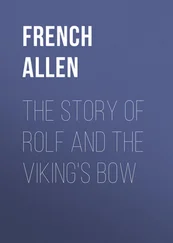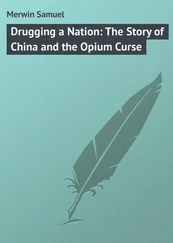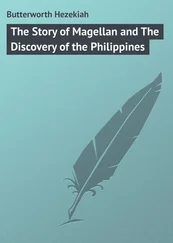Keith Moore, the Society’s librarian, reaches into an anonymous-looking metal cupboard and, with an air of gentleness and care, brings out a white box. Inside it, resting delicately, is an object that automatically provokes an awed hush: the death mask of Isaac Newton. Only by a remarkable chance did the mask come into the Society’s possession. It had been lost for many years when, in 1839, a Mr Christie, a Fellow of the Society, developed a sudden desire to have a bust of Newton on his shelves and called in at a curio shop on Tichborne Street in London, near his place of work, to ask if they had anything. The shopkeeper replied that he had no statues, but they had a curious mask, which his father had bought many years before. After some rooting around, he found it and brought it to Christie to examine. It was Newton’s death mask. It had sat unregarded on a shelf for at least half a century, and in all likelihood would eventually have
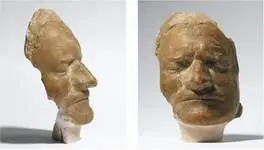
Isaac Newton’s death mask.
been lost altogether had Christie not made his lucky enquiry.
The mask is a transfixing object, not surprisingly, but what is more unexpectedly moving is a small, exquisite piece of apparatus that sits on the shelf alongside it: a reflecting telescope made by Newton himself in 1669. It is only six inches long but beautifully fashioned. Newton ground the glass himself, designed the swivelling socket, turned the wood with his own hand. In its time this was an absolute technological marvel, but it is also a thing of lustrous beauty. Nowhere could you find an item that more vividly demonstrates the beauty as well as the wonder of science.
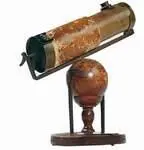
The reflecting telescope made by Newton in 1669.
Keith shows me some papers he has just been cataloguing. They are letters from Thomas Thorpe, an English chemist, written to his wife, Emma, during an 1878 Royal Society expedition to the American west. The purpose of the expedition was to view a solar eclipse, which, among other things, would allow them to confirm or disprove the existence of the planet Vulcan. The papers are irresistibly absorbing, partly because Thorpe brings a scientist’s curiosity to everything he sees – the quality of US trout, the character of the town of Cheyenne (home of ‘6,000 of the biggest scoundrels the world contains’), the climate, geology, everything – but also because they so vividly and charmingly catalogue the difficulties and discomforts necessary to do science in the field in the nineteenth century (or possibly any time).
When you look along the stacks or peek into the drawers, it is impossible not to be struck with wonder at how much aggregated human effort – how much thought and toil and nights under canvas – is embedded in what we know about the world and universe and how they are put together.
‘This is only a small part of it,’ Keith tells me. ‘There are eight thousand more boxes in storage in Wiltshire.’ He smiles. ‘You generate a lot of material in 350 years.’
Which brings me to my third remarkable fact about the Royal Society: it’s still there. More than that, it is still there and it is still important. How many enterprises can you name that are still doing today what they were formed to do 350 years ago?
It has had its moments of faltering, goodness knows. At times its quenchless curiosity has threatened to give way to mere morbidity. In the early days it was particularly fascinated with monstrous births and that kind of thing, and sometimes it engaged in experiments that were patently imprudent.
One such was in November 1667 when a penurious student named Arthur Coga was induced to let two Fellows transfuse sheep’s blood into him in return for the payment of a guinea. No one had any idea what would happen – whether it would kill him or fill him with boundless energy – and this degree of uncertainty left some of the more reflective members feeling distinctly uneasy. In the event, the transfusion didn’t do much of anything. Before an audience that included the Bishop of Salisbury, 14 ounces of blood were pumped out of the sheep and into Coga. It seemed to do him no harm. Afterwards, one of those present reported, ‘the patient was well and merry, and drank a glass or two of canary, and took a pipe of tobacco’. He went home, slept well and reported no ill effects. Just under two weeks later, the operation was repeated for a new audience. Soon afterwards, however, reports began to trickle in from all over Europe that the experiment had been tried several times elsewhere, often with fatal results. The Society, happily, never tried anything like that again.
If the Royal Society had done nothing after Newton, its fame would be secure. In fact, there were times when it looked as if it might not do much. Twenty years after Newton’s reign, it had a president, Martin Folkes, who was famous for slumbering through meetings, and financial difficulties that threatened to become insoluble. By 1740, barely half the Fellows could be counted on to pay their dues, and some were so severely in arrears that the Society’s accumulated deficit had risen to over £1,800 – a worrying sum for a private body of modest size. Partly to restore the balance sheet, it began taking in members who were distinguished but not terribly scientific. By the end of the century, Fellows included Edward Gibbon, Warren Hastings and even Lord Byron. Without actually ceasing to be worthy, it could easily have declined into something more peripheral and much less important.
Clearly that didn’t happen. At every critical moment throughout its history there has always been an Isaac Newton, a Joseph Banks, a Humphry Davy, a T.H. Huxley, a Lord Rutherford to give the Society clout and lustre, and to keep it firmly attached to scientific endeavour at the highest level.
Today the Royal Society’s interests remain an inspiration to recite. It provides 350 research fellowships and its grants support the work of 3,000 scientists all over the world. It bestows great numbers of medals and prizes, maintains an active programme of lectures and debates, and holds a beloved Summer Science Exhibition, which no one who appreciates science and can get to London should miss. It acts as the scientific conscience of the nation. It publishes seven journals, and an endless stream of papers. It remains emphatically international in its outlook, maintaining close links with ninety-one science academies around the world. If we have an Earth worth living on a hundred years from now, the Royal Society will be one of the organisations our grandchildren will wish to thank.
Poke your head through any door in the Royal Society building and what you are likely to find is people in meetings. They meet endlessly at the Royal Society. My own involvement, like that of most outsiders, has been as a member of committees – in my case a committee to select the winners of the annual books prize and another involved with the 350th anniversary celebrations – and on almost every visit to the building I have opened three or four wrong doors to find other people meeting. For a long time I wondered what they could possibly all be meeting about. Then I was given a copy of an extraordinary volume – a sturdy hardback called the Royal Society Year Book, which in about 500 pages summarises all that the Royal Society does in a year.
Flick through it at random and you find that it is involved in an impossibly varied range of activities. There is a Dorothy Hodgkin Fellowships Committee, a Hooke Committee, a Trans-Antarctic Association UK Advisory Committee, a Darwin Correspondence Project, a Sir Harold Hartley Lecture Committee, a Scientific Unions Committee, a South East Asia Rainforest Research Committee, a Newton International Fellowships Committee, a Rosalind Franklin Award Committee, and dozens and dozens more. There is even an Anatomy, Physiology, Endocrinology and Pharmacology (Except Clinical Aspects) of Animal Systems, Neurosciences, Psychology and Reproductive Biology, and Relevant Agricultural Studies Committee (known informally, and perhaps a bit mercifully, as ‘Panel 8’).
Читать дальше
